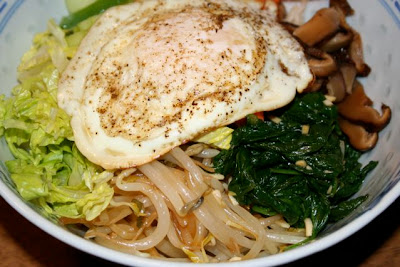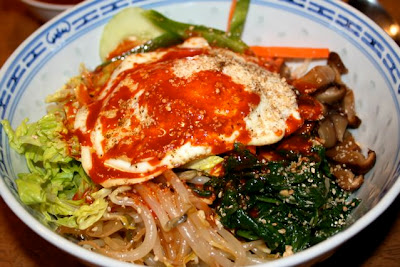 If you have a vegetable garden you know what this time of year is. Yes, zucchini overload! Now, there are tons of recipes out there for zucchini that are terrific. But I thought, why not do something a little bit different? I love Korean food and kimchee in particular. So, why not try using this wonderful summer squash in a spicy Korean relish? I looked around and there are few examples out there of zucchini kimchi but I do know that in Korea they make spicy pickles from all kinds of vegetables including summer squashes. What can be wrong with fresh vegetables, garlic, ginger and spicy red pepper? Nothing! I am happy to say my little experiment worked.
If you have a vegetable garden you know what this time of year is. Yes, zucchini overload! Now, there are tons of recipes out there for zucchini that are terrific. But I thought, why not do something a little bit different? I love Korean food and kimchee in particular. So, why not try using this wonderful summer squash in a spicy Korean relish? I looked around and there are few examples out there of zucchini kimchi but I do know that in Korea they make spicy pickles from all kinds of vegetables including summer squashes. What can be wrong with fresh vegetables, garlic, ginger and spicy red pepper? Nothing! I am happy to say my little experiment worked.
Zucchini Kimchee and Fried Rice
Cellophane noodle salad with Thai peanut sauce
 This noodle salad was perfect to take to a party this evening. Inspired by Thai cuisine, this dish used Korean mung bean cellophane noodles. These are usually used in the Korean dish called chop chae but instead I made a Thai style salad. I cooked the noodles until tender and cooled them under running cold water. The salad contained grated carrot, cucumber and green onions. The Thai peanut dressing was made from 3 tbsp natural creamy peanut butter, 2 tbsp rice vinegar, 1 tbsp fish sauce, 4 cloves garlic, and 1 Thai chili pepper. The sauce was pureed in the blender until good and smooth. This was tossed with the noodles and vegetables. It was quite a hit at the party!
This noodle salad was perfect to take to a party this evening. Inspired by Thai cuisine, this dish used Korean mung bean cellophane noodles. These are usually used in the Korean dish called chop chae but instead I made a Thai style salad. I cooked the noodles until tender and cooled them under running cold water. The salad contained grated carrot, cucumber and green onions. The Thai peanut dressing was made from 3 tbsp natural creamy peanut butter, 2 tbsp rice vinegar, 1 tbsp fish sauce, 4 cloves garlic, and 1 Thai chili pepper. The sauce was pureed in the blender until good and smooth. This was tossed with the noodles and vegetables. It was quite a hit at the party!
Daikon Kimchee
 Kimchee is a Korean staple and I really love the crunch of the vegetables and the sweet spice of the Korean red chili. Quite some time ago I posted a kimchee tutorial for making the classic fermented napa cabbage. There are many kinds of kimchee in Korea and daikon is another favorite vegetable for pickling in this way. I really enjoy the Korean daikon, which is more round and shorter than the typical daikon you find in most grocery stores. But you can use either for this dish. I actually used one large regular long daikon to make a batch. Two Korean bulbs would be about the same amount.
Kimchee is a Korean staple and I really love the crunch of the vegetables and the sweet spice of the Korean red chili. Quite some time ago I posted a kimchee tutorial for making the classic fermented napa cabbage. There are many kinds of kimchee in Korea and daikon is another favorite vegetable for pickling in this way. I really enjoy the Korean daikon, which is more round and shorter than the typical daikon you find in most grocery stores. But you can use either for this dish. I actually used one large regular long daikon to make a batch. Two Korean bulbs would be about the same amount.
The process I used to make this is similar to the cabbage variant. I diced the radish, salted it and let it sit for about an hour. After a good rinsing the diakon was tossed with one bunch of green onions, sliced; 5 cloves of garlic, chopped, 1 inch of fresh ginger, minced; about half a cup of Korean red chili flakes, and about a tablespoon of nuöc mam fish sauce. I prefer the Three Crabs brand. You don’t want to know how this is made! But it isn’t kimchee without some fermented fish. Traditionally, kimchee is prepared with chopped fish or fermented shrimp. This sauce makes it much easier to add that hint of fish. I also added a pinch of sugar. Mix everything well and let it sit out for at least a day then store it in the fridge. Unlike the napa cabbage kimchee, which I like well fermented and sour, I prefer my diakon kimchee fresh and sweet.
Bibimbap – Korean Comfort Food
 Bibimbap literally means ‘mixed up rice’ and is a traditional comfort food in Korea usually served in a warm stone bowl. I first tasted this delicacy many years ago at a Korean restaurant in Santa Clara, CA. I fell in love with the dish.
Bibimbap literally means ‘mixed up rice’ and is a traditional comfort food in Korea usually served in a warm stone bowl. I first tasted this delicacy many years ago at a Korean restaurant in Santa Clara, CA. I fell in love with the dish.
It starts, of course, with warm rice. I use Korean rice as it always cooks to the perfect sticky texture.
 There are many varieties of bibimbap and when made at home it usually includes whatever vegetables that are on hand at the moment. It also includes some grilled marinated beef. Our sirloin was marinated with soy, sesame oil, vinegar and a little sugar before grilling. Most of the vegies here are quickly sautéed and some are raw. We have cucumbers (raw), zucchini, red onions, carrots, spinach and garlic, and shitake mushrooms.
There are many varieties of bibimbap and when made at home it usually includes whatever vegetables that are on hand at the moment. It also includes some grilled marinated beef. Our sirloin was marinated with soy, sesame oil, vinegar and a little sugar before grilling. Most of the vegies here are quickly sautéed and some are raw. We have cucumbers (raw), zucchini, red onions, carrots, spinach and garlic, and shitake mushrooms.
 The vegetables were carefully placed on top of the rice putting complimentary colors next to each other to show off the variety of foods. The beef was placed on top.
The vegetables were carefully placed on top of the rice putting complimentary colors next to each other to show off the variety of foods. The beef was placed on top.
 I like the traditional way of seving a fried egg on top with a runny yolk, of course.
I like the traditional way of seving a fried egg on top with a runny yolk, of course.
 The dish was garnished with green onion. It is also served with sesame seeds and a spicy chili sauce made from gochujang paste, soy, sesame oil, vingegar and sugar.
The dish was garnished with green onion. It is also served with sesame seeds and a spicy chili sauce made from gochujang paste, soy, sesame oil, vingegar and sugar.
Bi Bim Bap (sans meat)
Bap (or bop) in Korean means rice. Bi bim means to ‘mix up’. Bi bim bap means to mix up stuff with rice. Traditionally in Korea this usually includes bulgogi style beef, various vegetables including bean sprouts, spinach, carrots, mushrooms, cucumbers among others, and always with a fried egg on top. This is mixed up with a spicy sauce and flavored with sesame oil and sesame seeds. Some of the vegetables are raw and some are cooked and marinated with sesame oil, garlic and soy. It is also traditionally served in a heated stone bowl. My take on it this time is hardly traditional on may fronts. I probably have vegetables that are not used commonly, I don’t have a special stone bowl to put on the fire, and after last evening’s t-bones I left out the beef. The flavor, however, is still quite good.
 I began preparing this dish early in the day. I steamed some mung bean sprouts just until tender. I did the same with baby spinach leaves; steamed just until they were wilted. These were marinated with a mixture of chopped garlic, soy sauce and sesame oil. I didn’t measure anything, so bear with me. I just splashed some together. I also hydrated some dried shitake mushrooms by boiling in a bit of water for about an hour. These were cooled and sliced. Other vegetables included raw carrots, raw green peppers and sliced romaine lettuce. These were all assembled on top of a bed of sticky Thai brown rice. An egg fried in sesame oil was placed on top.
I began preparing this dish early in the day. I steamed some mung bean sprouts just until tender. I did the same with baby spinach leaves; steamed just until they were wilted. These were marinated with a mixture of chopped garlic, soy sauce and sesame oil. I didn’t measure anything, so bear with me. I just splashed some together. I also hydrated some dried shitake mushrooms by boiling in a bit of water for about an hour. These were cooled and sliced. Other vegetables included raw carrots, raw green peppers and sliced romaine lettuce. These were all assembled on top of a bed of sticky Thai brown rice. An egg fried in sesame oil was placed on top.
 Before mixing this all up I added some sesame oil, sesame seeds and a spicy sauce. The sauce was made with gochujang paste (about 2 tbsp), rice vinegar (about 1/4 cup), soy sauce (about 1/4 cup), water (about 2 tbsp) and sesame oil (about 2 tbsp). Just mix everything together well and enjoy.
Before mixing this all up I added some sesame oil, sesame seeds and a spicy sauce. The sauce was made with gochujang paste (about 2 tbsp), rice vinegar (about 1/4 cup), soy sauce (about 1/4 cup), water (about 2 tbsp) and sesame oil (about 2 tbsp). Just mix everything together well and enjoy.




